Nuts and Bolts: What’s in a Whammy Bar?
It’s hard to love guitar music without falling in love with the whammy. From the subtle warble of surf to heavy metal dive bombs and the awesome textural variety of bands like My Bloody Valentine and Sonic Youth, it’s amazing what this little lever can do. Not every guitar has one of these bars. Among those that do there are a variety of different designs that each require a different setup.
Let’s start by getting the terminology straight: tremolo/vibrato/whammy bar/arm, and tremolo/vibrato system/tremolo bridge all refer to the same things. Technically, the effect is vibrato, because manipulating the bar changes pitch. Tremolo, on the other hand, refers to a change in volume. But the two terms have come to be used almost interchangeably.
How does it work?
There are two types of bridges: a fixed bridge does not accommodate a vibrato system, but a moving bridge does. A moving bridge allows for a change in string tension when the arm is pushed or pulled. Pushing the arm lowers tension, thereby lowering the pitch. pulling up on it increases string tension and raises the pitch. All vibrato arms are able to be pushed down, but not all can be pulled up.
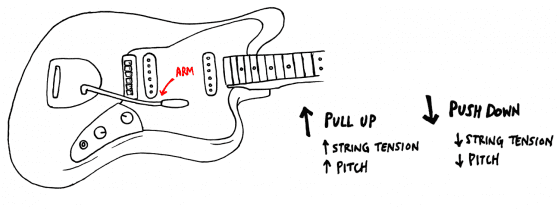
Types of Vibrato Systems
Two of the more common vibrato systems are synchronized tremolo and floating bridge.
Synchronized Tremolo
The Fender synchronized tremolo system—also known as the “strat trem” because of its origin as a part of the Stratocaster design in the early 1980s—utilizes springs in the body of the guitar. The bridge is anchored to these springs, and manipulating the arm will stretch or compress them in order to change string tension. You will seem them if you remove the backplate of your guitar (it’s easy, it just requires a Phillips-head screwdriver).
The floating bridge design is found on offset Fender guitars including the Jaguar and Mustang. The main advantage of floating bridge designs is that they allow for both pushing and pulling, so you can raise or lower your pitch. The “stang trem’s” has a reputation for being impossible to use without it detuning the guitar, but we won’t get into that here. The “jag trem” has its own set of issues, too, but it’s significantly less of a nightmare to set up.
Setting Up Your Vibrato System
There’s more than one way to set up a vibrato system, but anything you do will be specific to both the tuning and string gauge you use. The methods below are intended to avoid the all-too-common problem of the guitar falling out of tune after use of the vibrato arm.
Synchronized Trem
This is a quick method for setting up a strat trem to be “somewhat floating,” so that when you are finished you will have a pitch range of 1.5 steps on the G string, 1 step on the B string, and .5 on the E. I learned it from a brief YouTube video by luthier Galeazza Fruduo.
All you need is a tuner (even an app on your phone will work since there’s no need to be as precise as when intonating), a Phillips head screwdriver and some Post-Its.
- Remove the backplate to expose the springs that make this system work.

- Tighten the bolts holding the springs until the rear part of the bridge touches the top of the guitar. This will take about 10 or 11 turns.

- Turn the guitar over so you’re looking at the top. With the vibrato arm in the bridge plate, slide a stack of Post-Its between the bottom of the bridge plate and the body of the guitar so that the two are parallel. You’ll have to remove a small number of sheets at a time until you achieve this. We’re just eyeballing, but it should look about like this:

- With the Post-Its in place, tune the G string to pitch.
- Remove the Post-Its and lower the vibrato arm until the G string is ringing at E (1.5 steps below G).
- Find the amount of Post-Its that will keep the G string at E. Fruduo notes that it “doesn’t have to be absolutely perfect,” which is nice.
- Tune the whole guitar, then remove the Post-Its. The guitar will now be out of tune.
- Remove the vibrato arm and turn the guitar back over.
- Tune the guitar by loosening the springs in the back of the instrument: Hold the screws and turn them about 10 times in the opposite direction.
Floating “Jag Trem”
These systems are often set up improperly, and even when you have them set up to stay in tune they can create problems—either the arm swings or it falls into the body. Yet you’d be hard pressed to find a Jaguar player who doesn’t want to use the vibrato. Many players (myself included) eventually upgrade their vibrato systems, but there are a couple of DIY fixes that may prove useful, at least temporarily.
First let’s cover the setup. This method takes advantage of the “trem-loc” feature found on the jag trem. It was designed to keep the guitar in tune, but often goes unused. If you look at your bridge plate, you’ll see a button that you can slide toward/away from the arm. The system is locked when the button is pushed towards the arm.
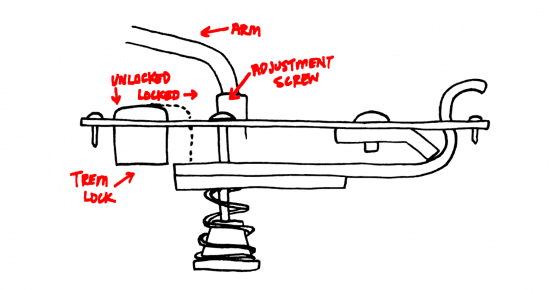
- With your guitar in tune, turn the tremolo height-adjustment screw so that you can’t engage the trem-loc without a slight push down on the arm.


When you push down on the arm, you’re pushing down the piece of metal it rests in, which would otherwise block the underside of the trem-loc button from moving. This is all happening inside the guitar, underneath the tremolo plate. you can’t move the button, loosen the adjustment screw by turning it counter-clockwise. This lowers the arm. - Tune again.
- Adjust the trem height so that you can slide the trem-loc back and forth without altering tuning.
Inside the guitar: the trem-loc mechanism just glides over the piece of metal holding the arm without pushing it down, which would lower the pitch.
This method makes it so that you can only push down on the arm, lowering your pitch. If you also want to be able to pull up without going out of tune all the time, it’s time to think about upgrading your system. I use the Mastery Vibrato in my Jaguar and I love it. Jaguars also have notoriously crappy bridges, and the Mastery is a great solution to another common Jaguar problem; strings jumping out of their saddles. It’s pricey, but your guitar will never go suddenly and wildly out of tune in the middle of a song again. Just make sure you purchase the correct bridge/vibrato for your specific guitar. You can use the serial number to determine where and when your guitar was made.
If you’re not ready to drop $175 on a new vibrato system but you’re having problems with your current one, here are some super quick fixes that may help:
Arm swinging/falling out? If you’re sure you have the right arm for your guitar, take it out and stick the bottom end of it into some potting soil. Then put it back in. The soil should provide more friction to hold it in place. Although you’ll have to repeat this once in a while, it does help in a pinch (If you don’t believe me, look it up). Some models take a threaded arm, which is screwed into the body. Others take unthreaded, which are the ones that tend to benefit from the potting soil move.
Arm falling into body? First of all, it’s worth noting that different models will have different springs, and some are stronger than others. If this keeps happening to you and you’re using heavy strings, you could use lighter strings, .11 or lighter. If you don’t want to use lighter strings, you can superglue it. Use Loctite Blue 242 Threadlocker. Remove the tremolo plate and apply Loctite Super Glue all around the nut that holds the thimble to the metal plate. Leave undisturbed for at least 10 minutes before replacing the plate.
The glue will cure it in 24 hours. Again, this is something you’ll likely have to repeat, but it should hold you over until your Mastery comes in the mail.
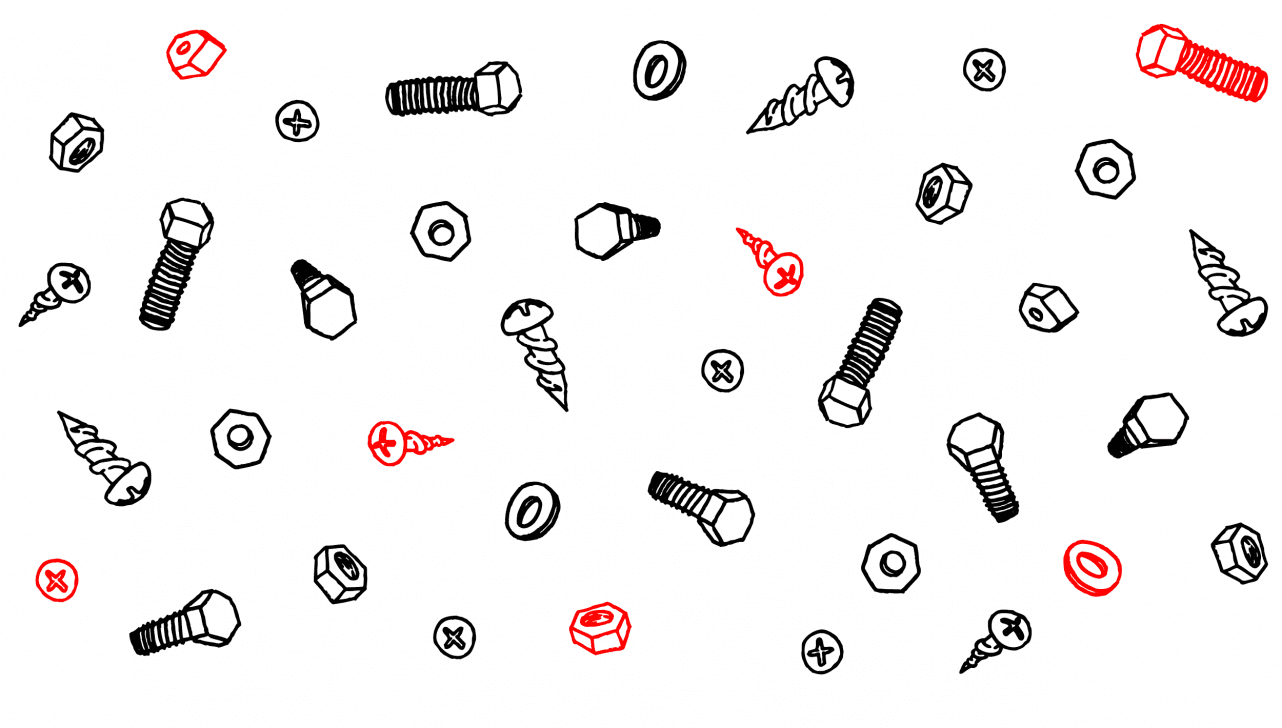
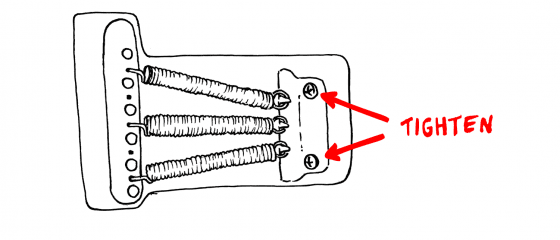
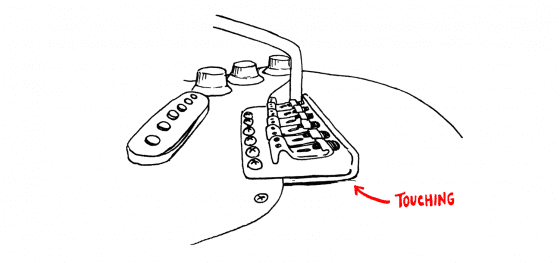
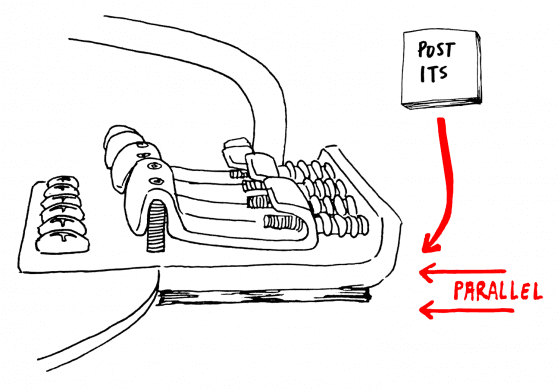
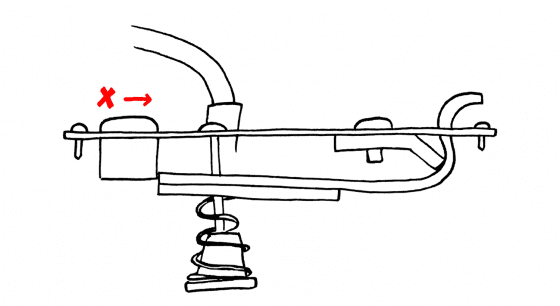
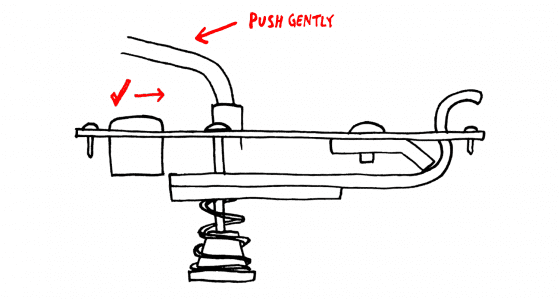





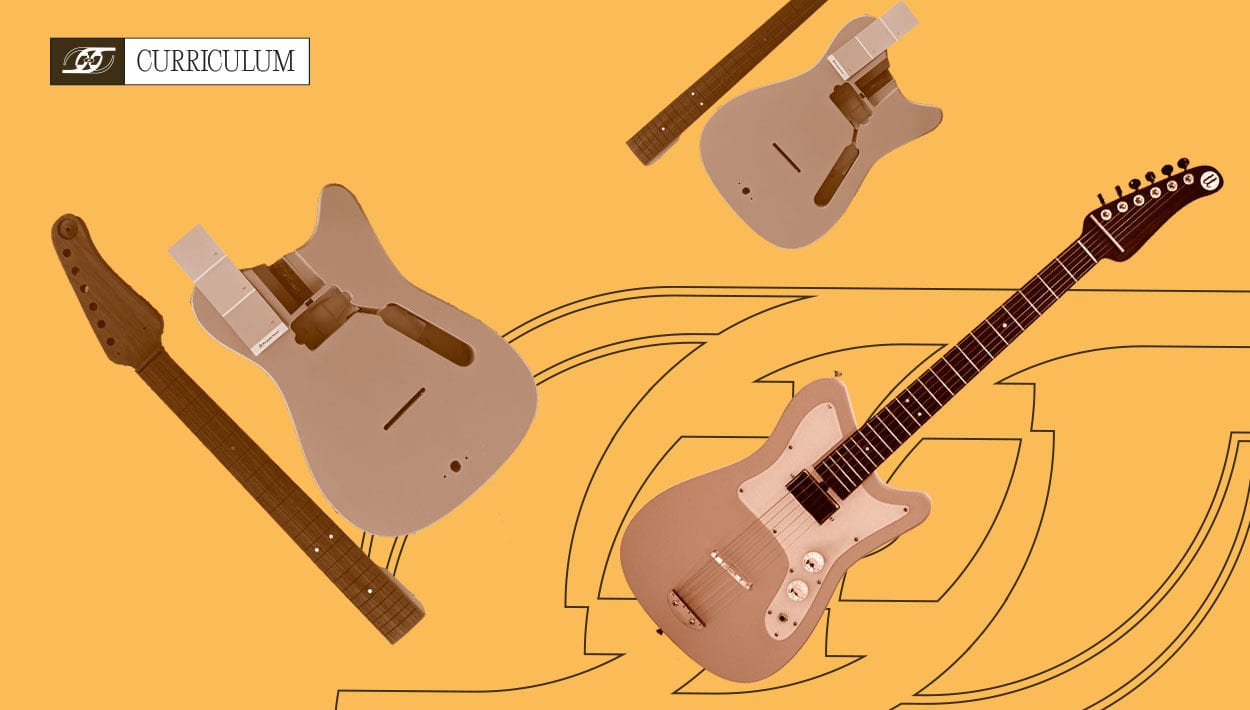
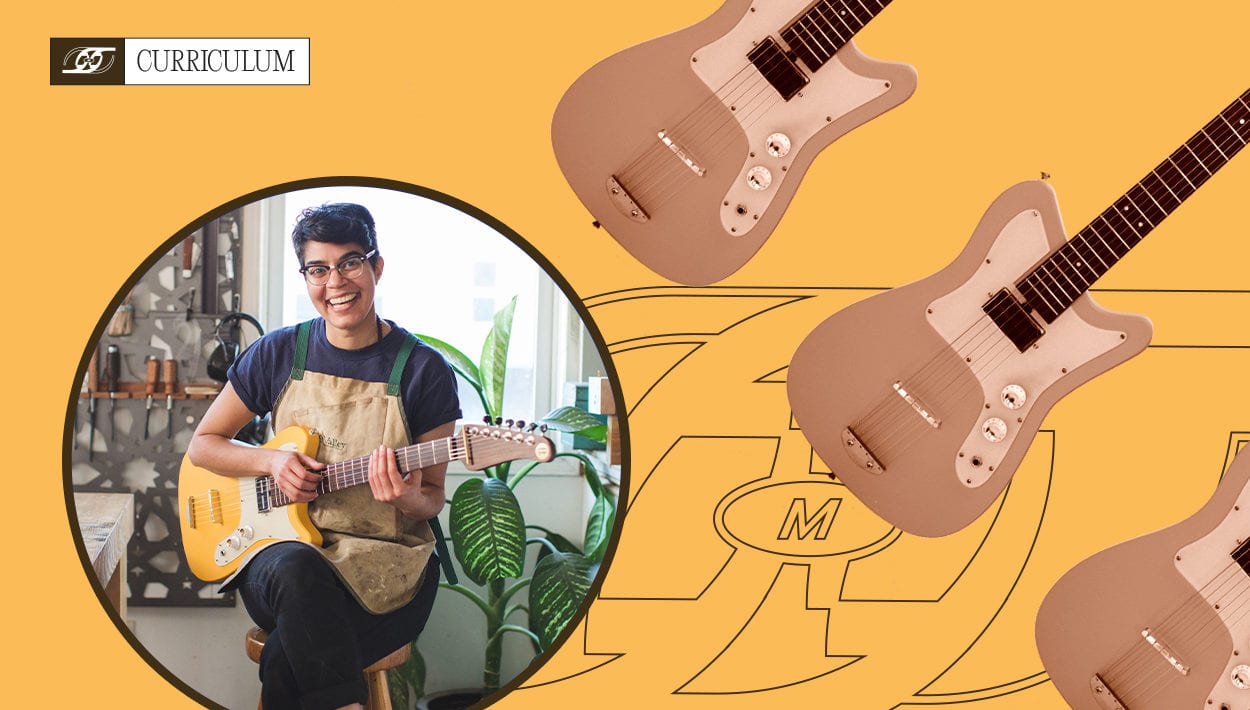






Comments
Leo Fender designed the Strat tremelo in the 50s not the 80s. This article is garbage.
Comment by Stan Kowalewski on July 16, 2018 at 6:53 pmWow this article is bad. It is confusingly written and seems overly fixated on Mustang/Jaguar trems. Do not cover your unthreaded arm in dirt. Firstly, it shouldn’t fall out the first place. On a Ibanez Edge (which use a pop-in arm that is similar to many other designs) the correct approach is to use either some plumbers tape, or put a bit of tissue in the bottom of the arm holder. I would never put my arm in potting soil. That would be ineffective and it would also fill my guitar with potting soil.
Seriously, how did you come up with that? Is it because this a magazine aimed at women you decided to condescend and go with ludacris suggestion of potting soil because you figured women would be more like to have a plat around than some plumber’s tape? If they don’t have it handy, it costs 70 cents and is available at any hardware store.
“because of its origin as a part of the Stratocaster design in the early 1980s” Wrong. Strats have had tremolos since the 50s, but nice try.
Also, what is all this shit about strings popping out of the bridge on a Jag/Stang? It was designed as an update of the original stratocaster trem. One of the issues with that the string can become unseated and tuning stability is affected—which is why there are “bullet” type strings that are supposed to stay in better. The jag/stang has a fixed point of intonation. The action of the strings, and their place in saddle is supposed to remain the same. That is why the bit that moves and what the strings are hook into are located behind and below the the bridge with the saddles fixed in place. The Kahler uses this same principle only modernized. In any case your strings should definitely not “pop out in the middle of a song”.
Considering this magazine has represented itself as the “voice of female guitarists” or at least some kind advocate for them one would think you’d be a little more motivated to write coherent articles. All this incompetent display does is reinforce the notion that women are bad at guitar.
Also, it is called “She Shreds Magazine” yet didn’t make any attempt to talk about Floyd Rose style bridges, Kahlers, or any of the modern two-point systems that are commonly available. Your drawings are too crude to make much sense and would have been better supplemented with some actual photos.
It isn’t clear to me how an arm could “fall in” (apparently this applies to Jazzmaster vibratos, not that this article makes it clear). I looked it up. Halfway down the second result the solution was either “put a bit a paper in there” or “plumbers tape”. It sure as hell was not to use Locktite.
“There are two types of bridges: a fixed bridge does not accommodate a vibrato system, but a moving bridge does. A moving bridge allows for a change in string tension when the arm is pushed or pulled. ”
I don’t even know why you included this confusing explanation. It doesn’t make any sense. Jazzmaster doesn’t have a moving bridge at all. It is the tailpiece that moves. The bridge and the point of intonation are set in place. On fulcrum style trems (synchronized tremolo, two-point, Floyd Rose, et cetera) the whole bridge does indeed move and the point of intonation is not fixed. Your categorization makes no sense. A guitar either has a vibrato system or it doesn’t. There isn’t a category of “moving” bridges that you can attach a vibrato. I don’t even know what point you are trying to make. It is just a needless and confusing aside that I suppose was put in with attempt of making you look more learned.
Comment by Dan on October 20, 2018 at 12:00 pm